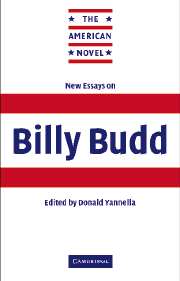Book contents
- Frontmatter
- Contents
- Series Editor's Preface
- List of illustrations
- Notes on contributors
- Introduction
- 1 Billy Budd and American labor unrest: the case for striking back
- 2 Religion, myth, and meaning in the art of Billy Budd, Sailor
- 3 Old man Melville: the rose and the cross
- 4 Melville's indirection: Billy Budd, the genetic text, and “the deadly space between”
- Select bibliography
- Index
2 - Religion, myth, and meaning in the art of Billy Budd, Sailor
Published online by Cambridge University Press: 02 December 2009
- Frontmatter
- Contents
- Series Editor's Preface
- List of illustrations
- Notes on contributors
- Introduction
- 1 Billy Budd and American labor unrest: the case for striking back
- 2 Religion, myth, and meaning in the art of Billy Budd, Sailor
- 3 Old man Melville: the rose and the cross
- 4 Melville's indirection: Billy Budd, the genetic text, and “the deadly space between”
- Select bibliography
- Index
Summary
Though I wrote the Gospels in this century, I should die in the gutter –
Melville's classic tale of the Handsome Sailor yields numerous interpretations. For me, Billy Budd is less a sea story than an allegorical fable about the relationship of truth to art. On the epistemological level, the tale illustrates how truth shifts during the creative process; here Melville uses elements of myth to question the Bible's truth. On an aesthetic level, Billy Budd reveals Melville's theory of art: the conflict between Billy and Claggart dramatizes the essential dialectic between the forces of light and dark, Hellenism and Hebraism. Finally, Vere as executor performs the crucial act necessary to transform Billy into a mythic hero.
The dialogical argument that had sustained Melville's long poem Clarel (1876), whether Christianity was “true” or not, was an issue in Moby-Dick (1851), The Confidence-Man (1857), and all his major works as a corollary to the larger epistemological problem: whether objective truth exists and if humans can ever know anything with certitude. As in “Benito Cereno,” Billy Budd, Sailor first presents the two central characters from a third person's “inside” point of view, then reverses our perspective with an “historical” footnote. Billy is presented as the archetypal hero while Claggart is the corrupt villain. Though Billy clearly violated military law, we are persuaded of the “exceptional” nature of the case: Billy was defending himself against a lie, and his killing of Claggart was unintentional.
- Type
- Chapter
- Information
- New Essays on Billy Budd , pp. 49 - 82Publisher: Cambridge University PressPrint publication year: 2002
- 1
- Cited by

